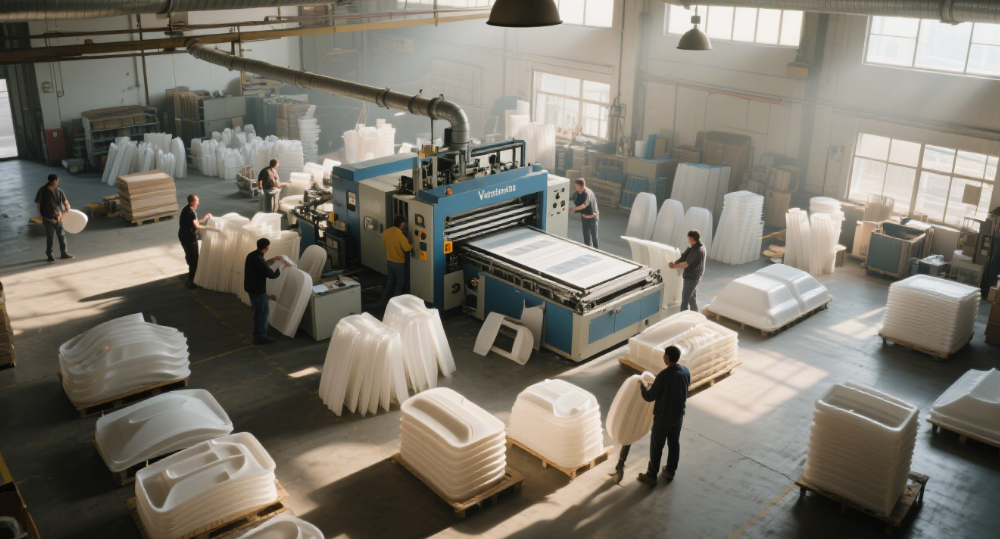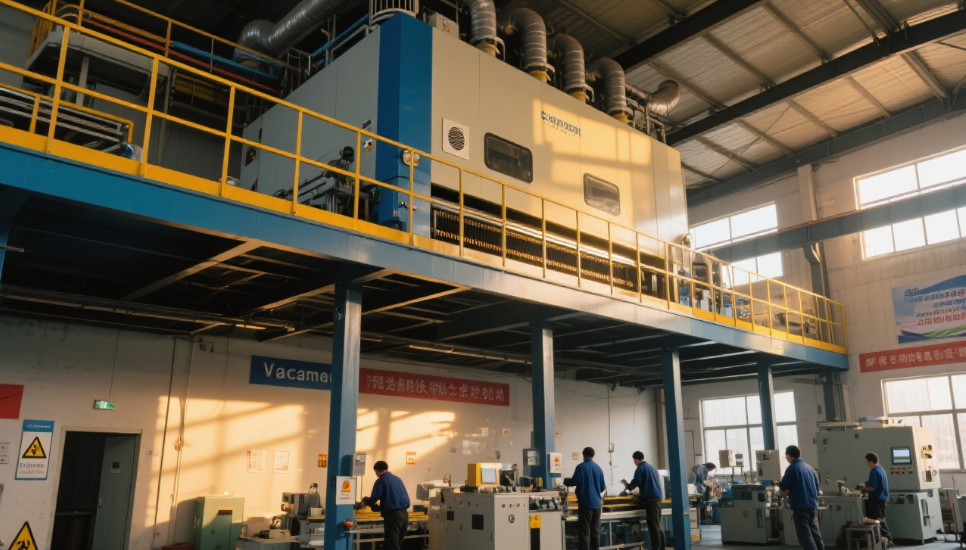Views: 0 Author: Site Editor Publish Time: 2025-07-18 Origin: Site
Are you considering vacuum forming for your next production project? If so, understanding the materials used in this process is crucial to your success. Choosing the right material for your vacuum forming machine can make a world of difference in product performance, production speed, and overall cost. Did you know that certain materials can reduce production times and costs while still maintaining the strength and durability of your final products?
In this article, we’ll explore the top five materials commonly used in vacuum forming, delve into their advantages, and provide insights on how to select the ideal material for your needs. Whether you’re involved in automotive manufacturing, packaging, medical equipment, or consumer goods, knowing the right material can enhance your production process. By the end of this article, you’ll not only understand the benefits of each material but also gain a clear sense of how to choose the best one for your specific application.
So, let’s dive in and explore the materials that are shaping the future of manufacturing!
Before we explore the materials, let’s quickly recap the vacuum forming process. Vacuum forming is a type of thermoforming, where a plastic sheet is heated to a pliable state and then molded over a tool or mold using vacuum pressure. Once the material cools and hardens, it takes on the shape of the mold, creating a precise and often complex shape.
This process is widely used in industries like automotive, packaging, medical devices, and consumer goods, thanks to its versatility, speed, and cost-effectiveness. However, selecting the right material for your vacuum forming machine is essential to achieving the desired product characteristics such as strength, clarity, flexibility, and cost.
Now, let's examine the five most popular materials used in vacuum forming and their unique advantages.

ABS is one of the most versatile and widely used materials in vacuum forming. Known for its toughness, impact resistance, and flexibility, ABS is often the material of choice for products that need to endure physical stress while maintaining their shape.
Advantages of ABS:
High Impact Resistance: One of the key reasons for choosing ABS is its ability to withstand high-impact conditions. This makes it ideal for products that will be subjected to wear and tear, such as automotive parts, electronics, and toys.
Good Heat Resistance: ABS can endure moderate to high temperatures, making it suitable for products exposed to heat. During the vacuum forming process, ABS retains its structural integrity without warping or degrading.
Ease of Fabrication: ABS is easy to cut, shape, machine, and paint, which means you can make modifications and customizations with ease. The material also bonds well with adhesives, making it perfect for products that require assembly.
Versatile Use: Whether it’s in the automotive industry, electronics, or household products, ABS offers a reliable and flexible solution that can be used in a wide range of applications.
Common Applications of ABS:
Automotive parts like dashboards, trims, and bumpers
Electronics enclosures for items like computers, printers, and TVs
Household items such as kitchen appliances, storage bins, and furniture
ABS offers a perfect balance of cost, durability, and ease of use, making it a go-to material in various industries. If you are looking to produce robust products that can withstand both physical and environmental stress, ABS is an excellent choice.
Polycarbonate (PC) is a high-performance thermoplastic that is known for its incredible strength and optical clarity. Polycarbonate is the go-to material when impact resistance and transparency are both required in a product, making it an indispensable option in industries that prioritize visibility and durability.
Advantages of Polycarbonate:
Exceptional Impact Strength: Polycarbonate is virtually unbreakable, making it one of the most impact-resistant materials used in vacuum forming. This is a critical feature for products that require extreme toughness, such as protective covers and automotive parts.
Optical Clarity: Polycarbonate is a transparent plastic, which makes it perfect for applications where clarity and visibility are crucial. For example, it is widely used in the production of lenses, safety shields, and light diffusers.
UV and Heat Resistance: Polycarbonate can withstand high temperatures and UV rays, making it suitable for outdoor applications where the material will be exposed to the sun for extended periods.
Versatility in Applications: Polycarbonate is not just strong but also versatile, and it can be formed into complex shapes without compromising its integrity. It’s widely used for a range of applications, including medical, aerospace, and electronics industries.
Common Applications of Polycarbonate:
Aircraft interior panels, trays, and windows
Medical equipment, including protective covers and trays
Automotive components like light lenses, mirrors, and guards
Optical products, including safety goggles, eyeglass lenses, and light diffusers
If you need a material that combines toughness, optical clarity, and resistance to UV radiation, polycarbonate is your ideal choice. While it may be more expensive than other materials, its performance in challenging environments justifies the investment.
Polyethylene, especially high-density polyethylene (HDPE), is one of the most commonly used thermoplastics in vacuum forming due to its incredible chemical resistance, durability, and versatility. Polyethylene is perfect for products that need to be resistant to chemicals and harsh environments.
Advantages of Polyethylene:
Chemical Resistance: Polyethylene is highly resistant to acids, alkalis, and solvents, making it ideal for applications where the product will be exposed to harsh chemicals. This is a major advantage in industries such as pharmaceuticals, chemical processing, and food packaging.
Lightweight Yet Strong: Despite its low density, polyethylene offers outstanding strength-to-weight ratio, making it both durable and lightweight. This is particularly beneficial for products that require robustness without adding excessive weight.
Impact Resistance: HDPE is tough and able to withstand considerable impact, even at low temperatures. This makes it suitable for both indoor and outdoor applications, especially in environments that require materials to resist physical stress.
Versatility in Use: Polyethylene can be used in a wide variety of products, from packaging to industrial components. It is one of the most flexible materials in vacuum forming, offering an excellent balance between performance and cost.
Common Applications of Polyethylene:
Chemical tanks and containers
Industrial packaging and shipping containers
Food packaging and storage solutions
Medical equipment and trays
Polyethylene is a go-to material for applications that demand chemical resistance and durability. Its ability to perform well in both outdoor and industrial conditions, combined with its lightweight nature, makes it ideal for producing functional products at an affordable cost.

Polypropylene is another popular material used in vacuum forming, known for its flexibility, toughness, and resistance to chemical exposure. This material is often selected for applications that require resilience, especially when products are exposed to fatigue, bending, or repeated use.
Advantages of Polypropylene:
Tough and Flexible: Polypropylene offers an excellent balance of flexibility and strength, making it perfect for products that need to bend without breaking. This feature is highly beneficial in automotive, packaging, and medical applications.
Chemical and Heat Resistance: Polypropylene is resistant to a wide range of chemicals, including acids and bases, as well as higher temperatures, ensuring the longevity and durability of the final product.
Low Cost: Compared to other thermoplastics, polypropylene is relatively inexpensive, making it an attractive option for high-volume production runs.
Lightweight: Polypropylene’s lightweight nature makes it ideal for applications where weight reduction is a priority, such as in transportation and packaging industries.
Common Applications of Polypropylene:
Food containers and packaging
Medical products such as trays, syringes, and components
Automotive parts like dashboards, bumpers, and interior components
Packaging materials such as plastic bottles and shipping containers
Polypropylene is a versatile, cost-effective, and reliable material that is commonly used across various industries. Its combination of flexibility, strength, and chemical resistance makes it ideal for products that need to endure frequent use and harsh conditions.
Polystyrene is one of the most common and affordable materials used in vacuum forming, particularly in high-volume applications. Known for its ease of processing and affordability, polystyrene is a go-to for manufacturers who need cost-effective solutions without compromising on quality.
Advantages of Polystyrene:
Low Cost: Polystyrene is one of the most economical thermoplastics, making it a great choice for large-scale manufacturing where cost is a significant factor.
Ease of Molding: Polystyrene is easy to heat and mold, and it retains its shape well during the vacuum forming process. This makes it a preferred choice for producing detailed parts with sharp features.
Versatile Applications: Despite its low cost, polystyrene can be used to produce a wide range of products, including packaging, toys, and signage.
Customizable Finishes: Polystyrene is available in a variety of finishes, including glossy, matte, and textured, allowing for a high degree of customization in product design.
Common Applications of Polystyrene:
Packaging products like blister packs and clamshells
Disposable products such as cutlery, cups, and trays
Display products and point-of-sale displays
Toys, models, and promotional items
If you need to manufacture large quantities of products with intricate designs at a low cost, polystyrene offers excellent value for money. Its affordability and ease of molding make it ideal for industries with tight budgets and high-volume production runs.
When selecting the ideal material for your vacuum forming machine, consider the following factors to ensure you get the best results:
End Use: What is the product’s primary function? Will it be exposed to physical stress, chemicals, or high temperatures? For example, if your product needs to be impact-resistant, choose materials like ABS or polycarbonate.
Design Complexity: If your design involves intricate features, consider materials that are easy to mold and form, like ABS, polycarbonate, or polystyrene.
Durability Requirements: Consider how long the product will last and the conditions it will face. Materials like polycarbonate and polyethylene offer exceptional durability and resistance to environmental factors.
Cost Efficiency: If you're working within a budget, materials like polystyrene and polypropylene can offer a more affordable solution without sacrificing performance.
Environmental Considerations: Some materials are more sustainable and recyclable than others. If sustainability is a priority, look into recyclable options like polypropylene and polyethylene.
Choosing the right material for your vacuum forming machine is essential for producing high-quality, durable, and cost-effective products. Whether you opt for the impact resistance of ABS, the optical clarity of polycarbonate, the chemical resistance of polyethylene, the flexibility of polypropylene, or the affordability of polystyrene, each material offers distinct advantages for different applications.
At Wenzhou Mingdu Machinery, we provide top-of-the-line vacuum forming machines that can efficiently process these materials, ensuring you achieve the best results for your production needs. No matter what material you choose, our machines are designed to meet the demands of your industry while delivering precision and reliability.
A: For outdoor applications, polycarbonate and polyethylene are ideal due to their UV resistance and durability. Polycarbonate is particularly suited for applications that require clarity, while polyethylene offers excellent chemical and weather resistance.
A: The best material depends on the product’s function, the complexity of the design, and the environmental conditions it will face. If in doubt, consult with a professional or manufacturer to help you select the most suitable material for your application.
A: Yes, vacuum forming machines are highly effective for high-volume production. Materials like polystyrene and polypropylene are particularly well-suited for mass production due to their affordability and ease of processing.
A: Yes, vacuum forming can handle complex shapes, especially when using materials like polycarbonate, ABS, and polystyrene, which are flexible and easy to mold.
A: Regular cleaning and maintenance are essential. Be sure to clean the heating elements, vacuum system, and molds to keep the machine running efficiently and prolong its lifespan.
content is empty!